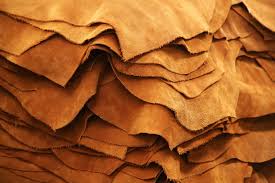Leather conditioner is the perfect cure for tired, worn and dry looking leather. That’s why I thought an all you need to know guide on conditioning leather would be the most helpful solution for anyone who has questions on the subject.
Leather conditioner is a specially formulated cream or oil which is rubbed into leather in order to prevent it from cracking as well as becoming dry and stiff. The conditioner penetrates deep into leather and replenishes lost oils & moisture and provides and external protective barrier.
Let’s take a closer look at what conditioners do for leather, how often they must be applied, its benefits for leather as well as which leathers shouldn’t be conditioned.
What are leather conditioners made from.
The best conditioners are oil based and shouldn’t contain any waxes or silicones in them. Oils will soak into and penetrate deep into leather in order to replenish it. Wax based conditioners, although helpful for waterproofing leather, can actually block leather pores, preventing the oils from penetrating inside and also stopping excess oils being excreted.
There are many types of conditioners on the market, and many of them contain Neatsfoot oil or Mink oil as well as lanolin and some contain beeswax and chemicals. I try to avoid conditioners which contain waxes, chemicals and especially Mink oil as this tends to darken leather.

Some conditioners, such as Leather Honey keep their recipe a closely guarded secret and only state that they contain no animal products, waxes, silicone or toxic chemicals. It doesn’t contain honey either and they have been producing leather conditioner for over 50 years. It’s definitely a product I can recommend.
What do leather conditioners do for leather.
Good leather conditioners are essential in maintaining leather quality, moisture and softness. Without them, leather would eventually dry out, crack and peel and degrade to such an extent that it would need to be thrown away. Conditioners increase the lifespan of your leather and allow it to age beautifully.
Conditioners penetrate deep inside leather helping to replenish oils and moisture which are lost during everyday use and exposure to the sun and other elements. They help maintain a good PH balance on the inside leather. They also allow leather to age gracefully and naturally by getting rid of dirt and grime.
How often should you condition leather.
The most important question to ask is, how often do you use the item? Is it a leather jacket, handbag, sofa or a wallet you carry around with you everyday? Frequency of use has an impact on how often it should be conditioned. A couch or jacket that is worn or exposed to the harsh sun all day will need to be conditioned more regularly than one in the shade.
A good leather conditioner should last for at least 6 months. Conditioning should be done at least once every 6 months and that should be sufficient. If you notice that your leather sofa is looking dry and stiff as it is exposed to the sun all day, it can be conditioned more regularly. Let’s say once every 4-5 months as the sun has a big impact on the lifespan of leather. It’s important to note that you shouldn’t over-condition leather as this can also be detrimental to its life.
Weather conditions and climate play a big role in the life of leather. Slushy, muddy, wet conditions are not great for shoes, boots and jackets as water actually dries out leather. It sounds counter intuitive, but water will be absorbed into leather and bind with the oils inside. When it’s hot, the water inside will evaporate, taking the vital oils with, which results in dried out leather. If this happens regularly your leather will degrade quickly and you will need to condition more often.
How Much leather conditioner should you use.
Rather use too little conditioner than too much as you can always apply more. Most conditioners come with handy directions for use, and these should be followed. Using the incorrect amount could result in darkening or oversaturating the leather. Always first test the conditioner on a spare piece of leather to gauge its effect. If there isn’t any spare leather, test it on an unseen or less noticeable part of your leather. Then leave it to soak in for a few hours in order to gauge the result to see if there are any side effects.

How to apply leather conditioner.
Firstly, the leather that you wish to condition must be cleaned of all dirt and grime and allowed a suitable time to dry. The best way to clean leather is by using a soft clean cloth that can be slightly dampened with water. A suitable leather cleaning agent can be applied to the cloth. Clean by hand. Important note: Do not put your leather in a washing machine to clean it and definitely don’t soak your leather in water. Cleaning with Saddle soap is also an option to get a clean dirt free surface.
First clean the leather surface of any dirt.
- First wipe the leather with a dry cloth to get rid of any immediate surface dirt build up.
- Next use a slightly damp cloth to wipe the surface. Or an alternative solution is if you have leather cleaner or saddle soap. These can also be used to clean the surface of any excess dirt.
- Now wipe the leather again with a slightly damp cloth to get rid of any moisture, soap or leather cleaner residue.
- Allow the leather to dry for a few hours and store out of direct sunlight.

Now that the prep work has been done and you are sure that the leather is sufficiently well cleaned, we can begin to apply the leather conditioner. It’s Important to remember to first test your conditioner on a small patch of leather that is preferably not visible. This is to check that there is no reaction with your leather and conditioner.
Depending on the leather conditioner you use, you will need to allow for some darkening. Some conditioners do darken leather more than others, especially ones that contain mink oil. This will be more noticeable on lighter toned leathers. Please check that your conditioner is compatible with your leather.
- Firstly, apply a small amount of leather conditioner to a soft clean cloth. Always use less conditioner as you can always add more later. Never apply the conditioner directly onto the leather always apply it to the cloth first.
- Do a test and rub the conditioner in an area where it’s difficult to see. Once applied wait a few minutes to see if there is any adverse reaction. If you are happy, you can apply the conditioner with a cloth in a circular motion. Don’t rub too hard and try to get into all those hard-to-reach areas.
- Now use a soft dry cloth to rub the surface in order to create a nice sheen. Do this to the entire surface and all areas of the leather.
- Then allow the leather to stand for a few hours and dry completely before using it.
Benefits of conditioning leather.
The benefits of using conditioner far outweigh the negatives.
- Increases the life of your leather.
- Moisturize’s your leather internally and externally.
- Prevents the leather from becoming brittle and cracking.
- Prevents the leather from drying out.
- Conditioning leather helps give it a beautiful, aged look and rich patina.
What are the best leather Conditioners.
There are many conditioners on the market, and some have been around for decades eg. Leather Honey. In my opinion this conditioner has stood the test of time and proven themselves to be among the best available. You can’t stay in business for 50 years and not have a great product. Not all conditioners are created equal as some contain chemicals, waxes or need to be applied more often.
The best conditioners should have the following properties or characteristics:
- Contain no animal products.
- Be water repellent.
- Have no or little odour or are unscented.
- Contain no wax.
- Must be non-toxic.
- Contain no silicone.
- One Treatment should last at least 6 months.
Leather Honey fulfils all of the above and there is no other conditioner that can match it for quality.

Other good conditioners that are available are: Chamberlains Leather Milk, Leather Nova Conditioner, Lexol Leather Care, Chemical Guys Leather Conditioner.
Is leather cleaner the same as leather conditioner.
No, a leather cleaner is different to leather conditioner. Leather cleaners are used for cleaning the surface and removing dirt, stains and grime from leather. Leather conditioners function by penetrating deep inside leather in order to replenish lost oils and moisture.

Leather balm or polish is also not the same as a conditioner. Leather balms or polish usually contain waxes which help with waterproofing leather which give the surface an extra shine. A polish is a short term solution for keeping your leather looking bright and shiny, but it does not condition.
Can you use conditioner on Suede and Nubuck.
No, you can’t apply regular oil-based conditioners to Suede or Nubuck as they require a dry method of cleaning. Suede and Nubuck are softer and less durable and stain easily. Water or liquid is suede’s worst enemy. Suede is much more labour intensive to own than full grain leather. The makeup and roughness of the surface make it easy for dirt and grime to be collected. A rubber pencil eraser is often used to remove stains on suede. A nylon brush can also be used to give it a good cleaning scrub. Under no circumstances should leather conditioner be used on suede or nubuck leather as it will result in damage.

Conclusion
Leather conditioners are crucial for keeping leather soft, supple and in optimal condition as they help maintain a balance inside leather. Applying conditioners every 6 months will help extend the lifespan of leather. If you are interested, check out my previous post on the lifespan of leather to learn a bit more on how to make leather last for decades. Thanks for reading.
